In university, I took an interest in my family tree. Searching the web, I found names of ancestors and cousins that I never knew I had. As my tree grew, I began to wonder where the Nyveen family name came from. What did it mean? Who was the first to use it?
My grandfather once told me that our Dutch last name was originally spelled “Nijveen” and was originally pronounced like this. My father elaborated, saying that the name is made of two parts:
- “nij” – means “new” in old Dutch (replaced by “nieuw” in modern Dutch)
- “veen” – means “bog”
Bogs are wetlands that receive water from precipitation and accumulate peat, a deposit of dead plant material. Native Dutch speakers I’ve consulted say that, depending on the context in which it’s used, “veen” sometimes refers to the peat itself.
Etymology of the word “veen” shows how it has changed over time:
- from Middle Dutch vēne (mire, bog)
- from Old Dutch *feni (fen, marsh, swamp)
- from Proto-Germanic *fanją (fen, marsh, swamp)
These roots also produced the English word “fen”, now classified as a different type of wetland. Boston’s Fenway Park is so named because of the fens and marshes that historically existed in the surrounding area.
So these words gave me a good head start. But why was the name chosen by my family? Who was the first to use it and when?
A Short History of Surnames
In the history of human civilization, surnames were a gradual development. As communities grew into villages and towns, people needed ways to identify each other more specifically. Around 500 BC, as Rome grew in area and population, the Romans began using a family name for each household, becoming perhaps the first to use surnames. With the fall of the Roman Empire in 476 AD, new naming conventions developed, but usage was always inconsistent and informal. In England, the compilation of the Domesday Book by William the Conqueror in 1086 required that people have surnames, but they did not come into common usage in England until the late 1200’s. In the Dutch Republic (1581–1795), children were traditionally given patronymic surnames (based on their father’s names) until the French invasion in 1795.
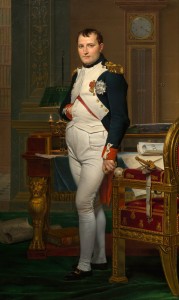 In an attempt to enforce trade bans and regulate shipping between Holland and Britain, Napoleon annexed the Kingdom of Holland in 1810, placing it under direct French rule. On August 18, 1811, Napoleon introduced the civil registry and instituted the mandatory registration of births, deaths, and marriages, forcing the Dutch to register and adopt distinct surnames. According to the decree:
In an attempt to enforce trade bans and regulate shipping between Holland and Britain, Napoleon annexed the Kingdom of Holland in 1810, placing it under direct French rule. On August 18, 1811, Napoleon introduced the civil registry and instituted the mandatory registration of births, deaths, and marriages, forcing the Dutch to register and adopt distinct surnames. According to the decree:
Those of our subjects of the Departments of the former Holland… who until now have not had fixed surnames and given names, must adopt them during the year, and declare them before the officers of the civil registry… where they reside…
Those having known surnames… will be excepted. They who wish to conserve their names will nevertheless be required to declare them.
If they didn’t already have a name, locals could choose one they liked and register it at their local city hall.
Kinds of Surnames
So how did people who previously did not have a surname pick one? In general, European surnames can be grouped into five categories:
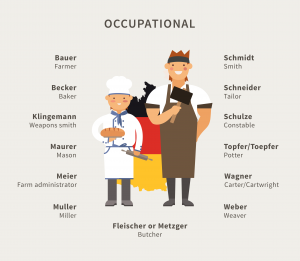 occupational names
occupational names
Smith/Schmidt/Lefebvre/Herrera/Kowalski = blacksmith
Cooper/de Kuiper = barrelmaker
Hunter = kills animals
Tanner = gets animal skins from the hunter to make leather
Fletcher = arrowmaker
Archer/Bowman = shoots arrows from the fletcher
Warner = guard/soldier
Baker/Becker/Fournier = makes pies
Brewer = makes beer
Bierman = a beer man: tavern owner, beer merchant, brewer, or a nickname for a beer drinker (Dutch/German)
Potter/Topfer = makes things to hold plants and stews
Weaver/Weber = makes clothing and textiles
Thatcher = makes roofs from straw or reeds
Fleischer/Metzger = butcher
Shoemaker/Schumacher/Zapatero = makes foot things
Singer/Cantor = uses voice to make pleasant sounds
Skinner = removes the outer covering of animals
Fisher/Visser = catcher of seaborne animals
Miller/Mulder/Mullins/Molinero = operates a mill which turns grain into flour
Seltzer = person who sold or extracted salt
Garner = someone in charge of the stores kept in a granary, or lived near a barn or granary
Carpenter/Zimmerman/Timmerman = builds stuff with wood
Turner = turned wood, bone, or metal on a lathe to make things
Mason/Maurer = builds things with stone
Eisenhauer/Eisenhower = iron worker
Chandler = candlemaker
Carter/Cartwright/Wagner = pushed a cart or wagon
Gardner = planted flowers
Harper = played the string instrument
Faulkner = falconer, or falcon trainer
Paquet = gatherer or seller of firewood (French)
Page = servant or page (French)
Taylor/Schneider/Kravitz/Couture = tailor
Schindler = shingler, roof tiler
Cohen = priest
Vogalaar = bird catcher
Bauer/Gagne = farmer
Meier/Meyer = farm administrator
Schultz = constable or village headman, responsible for collecting dues and paying them to the lord of the manor
Murphy = sea warrior (Irish)
Brodeur = embroiderer (French)
Chevrolet = goat farmer (French)
Segal = grower or seller of rye (French)
Cabrero = goatherder (Spanish)
Cavallero = horseman, knight (Spanish)
Hidalgo = nobelman (Spanish)
Torrero = bullkeeper, fighter (Spanish)
Gruber = miner (Austrian)
Spears = policeman or maker of spears (Old English)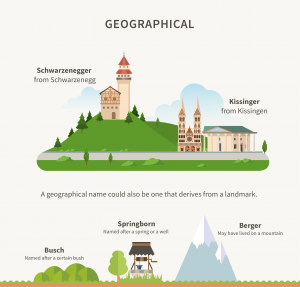 geographical names
geographical names
Ford = shallow part of a river
Martin = settlement by a lake
Brook = a small stream
Hill = a giant pile of dirt
Bush/Busch = near a notable bush
Perry = near a pear tree
Springborn = named after a spring or well
Berger = may have lived on a mountain
Knapp = hilltop
Beaumont = beautiful hill (French)
Flowers/Flores = near plants that bloom
Chastain = near certain chestnut trees (French)
Deschamps = from the fields (French)
Dupont = by the bridge (French)
Dupuis = by the well (French)
Stein = stone
Moore = near a moor (Middle English “mor”, meaning “open land” or “bog”)
Fielding = near a pasture or open country (Old English)
Wood/Woods/Dubois = forest
Eastwood/Westwood = the eastern/western part of a forest
Kirk = near a church
Middleton = middle town
Norman = from Normandy
van Rijn = from the Rhine
Schwarzenegger = from Schwarzenegg, Switzerland or Schwarzenegg, Austria (the town itself means “black ridge” in German)
Kissinger = from Kissingen, Germany
Walsh = from Wales (Irish)
Serrano = highlander (Spanish)
Vega = meadow (Spanish)
Mendoza = cold mountain (Spanish)
Morales = blackberry groves (Spanish)
Torres = towers (Spanish)
Iglesias = churches (Spanish)
Aguilera = eagle’s nest, or habitational name from a place in the Soria province (Spanish)
Rosenbaum = rose tree (German and Yiddish)
Timberlake = habitational name from a lost place in the parish of Bayton, Worcestershire, presumably named because a nearby lake was used to collect harvested timber (English)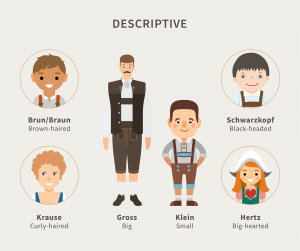 descriptive names
descriptive names
Little/Short/Klein/Petit = small person
Long = tall person
Gross/Legrand = big person
Rich = lots of money
Wise = lots of brains
Armstrong = good at wrestling
Young/De Jong = not old
White/Weiss/Witt/Blanco = white hair, complexion, or clothing
Leblanc/Rubio = blonde hair (French)
Black/Schwartz = black hair, complexion, or clothing
Brown/Braun/Moreno = brown hair, complexion, or clothing
Krause = curly-haired
Schwartzkopf = black-headed
Hertz = big-hearted
Cameron = crooked nose (Gaelic)
Campbell = crooked mouth (Gaelic)
O’Sullivan = people agree that the basic surname means “eye,” but they do not agree whether the rest of the name means “one-eyed,” “hawk-eyed,” “black-eyed,” or something else
Hubert = combines words meaning “heart,” “mind,” “spirit,” “bright,” and “famous” (German)
Alvin = means “elf friend” (Old English/Swedish)
Hillary = derived from words meaning “cheerful,” “glad,” “propitious,” and “joyful” (Latin/Greek)
Bravo = brave (Spanish)
Cano = grey (Spanish)
Cortes = courteous (Spanish)
Delgado = thin (Spanish)
Garza = long-legged (Spanish)
Orejon = big ear (Spanish)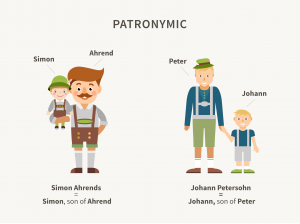 patronymic/affiliation names
patronymic/affiliation names
Johnson/Jones = son of John
Anderson = sone of Ander
Wilson/Williamson = son of William
Jackson = son of Jack
Davidson/Davis = son of David
Sanderson/Sanders = son of Sander/Alexander
MacDonald = of the Donald clan (Irish/Scottish, a person was identified by his given name plus “mac,” meaning “son of,” followed by his father’s name.)
McGowan = son of a smith (Irish)
O’Brien = of the Brien clan (Irish, the prefix “o” was sometimes used in place of “mac” and meant “grandson of” or “descended from.”)
O’Clary = descended from a clerk (Irish)
Fitzpatrick = son of Patrick (Norman-French/Irish, the Latin-derived prefix “fitz,” meaning “son of,” gained popularity after the Norman invasion of 1169)
Magnusdottir = daughter of Magnus (Icelandic)
Dominguez = son of Domingo (Spanish)
Hernandez = son of Hernando (Spanish)
Lopez = son of Lope (Spanish)
Ramirez = son of Ramiro (Spanish)
Dimitrov = Dimitar’s or son of Dimitar (Russian)
Ivanov = Ivan’s, or son of Ivan (Russian)
Interestingly, the names of actors Michael Madsen and Mads Mikkelson could be considered inverses of each other.- ornamental/story names
Morgenstern = morning star
Freeman = free man
Presumably, Nijveen was a geographical name, describing either a specific bog or a more general area where there were bogs. Not a flattering kind of place to be named after, but what can I do.
A Short Lesson in Wetland Ecology
Let’s explore some of these words used to describe different kinds of wetlands… The language has evolved and overlapped over the years, especially as words and usage from different languages have collided and mixed. In American English, we seem to have finally arrived somewhere stable.
A “mire” is the word to describe a wetland area dominated by living, peat-forming plants. There are four types of mires:
- A bog, due to its elevated location relative to the surrounding landscape, obtains most of its water from rainfall. Bogs are acidic and nutrient-poor.
- A fen is located on a slope, flat, or in a depression with water in the soil or groundwater flowing through it. Fens may be slightly acidic, neutral, or alkaline, and either nutrient-poor or nutrient-rich.
- A marsh is a type of wetland with vegetation rooted in mineral soil. They are rich in nutrients and are overgrown with grasses and leafy vegetation. Some marshes form shallow peat deposits.
- A swamp is characterized by their forest canopy with waterlogged trees and other plans. Like fens, swamps are typically more alkaline with more nutrient availability than bogs.
Incidentally, there is an overlapping term, “moor”, which describes an area of raised, open land with low-growing vegetation or low-lying wetlands with acidic peat vegetation. A wet moor is generally synonymous with bog.
It’s hard to keep it all straight, especially when considering that “veen” in Dutch might mean a bog or the peat therein.
But what’s so special about peat? And why might it play a part in the origin of my Dutch last name?
For Peat’s Sake
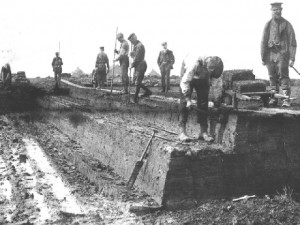 Peat is a bed of partially decayed vegetation that forms on the floor of a bog or a fen. Peat deposits take thousands of years to grow and can be found in layers up to five meters thick. When compressed and dried, peat burns hot and with little pollution, making it a valuable energy source.
Peat is a bed of partially decayed vegetation that forms on the floor of a bog or a fen. Peat deposits take thousands of years to grow and can be found in layers up to five meters thick. When compressed and dried, peat burns hot and with little pollution, making it a valuable energy source.
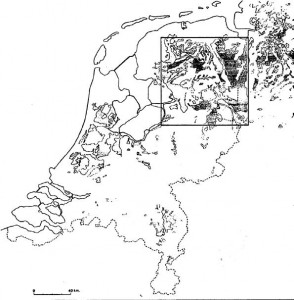 In the 16th century, bogs covered large parts of Holland, making peat cheap and widely available. But in the west, where cities grew fast, the relatively small amounts of peat around Amsterdam were used up by the 17th century. Attention turned to the northern and eastern parts of the country, where the large bogs of Friesland, Groningen, and Drenthe had vast reserves of peat.
In the 16th century, bogs covered large parts of Holland, making peat cheap and widely available. But in the west, where cities grew fast, the relatively small amounts of peat around Amsterdam were used up by the 17th century. Attention turned to the northern and eastern parts of the country, where the large bogs of Friesland, Groningen, and Drenthe had vast reserves of peat.
This vast and inaccessible moorland area had been settled in the Middle Ages by farmers using it for grazing and meadows, but it was mostly undeveloped. Eventually, small towns were built on what little dry land could be found. In the 18th century, when the growing value of peat as an export led to an economic boom, large-scale excavations for peat started.
Looking at a modern-day map of this region, a curious pattern emerges. Many of the towns near these bogs have adjacent towns with a “veen” suffix added onto them.
| Town | Adjacent Town |
|---|---|
| Gieten | Gieterveen |
| Bonnen | Bonnerveen |
| Drouwen | Drouwenerveen |
| Bronneger | Bronnegerveen |
| Buiner | Buinerveen |
| Gasselte | Gasselternijveen |
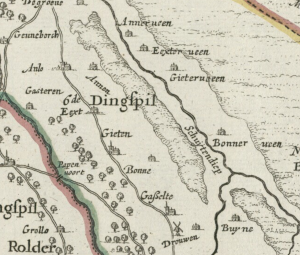
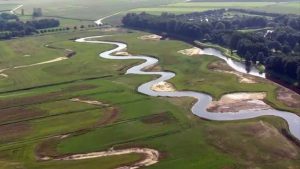
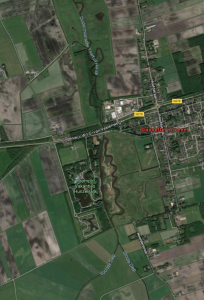 My best guess is that, back in the day, most people lived in the main towns, and these “veen” outposts near the bogs is where the peat harvesting took place. And as the years went by, these “veen” outposts gradually became their own full-fledged towns. Several 17th and 18th century maps that show these towns were indeed separated by a bog and a stream called Schuyten Diep. The stream was presumably used to transport the peat to economic centers like Groningen.
My best guess is that, back in the day, most people lived in the main towns, and these “veen” outposts near the bogs is where the peat harvesting took place. And as the years went by, these “veen” outposts gradually became their own full-fledged towns. Several 17th and 18th century maps that show these towns were indeed separated by a bog and a stream called Schuyten Diep. The stream was presumably used to transport the peat to economic centers like Groningen.
In the 20th century, with the peat supply running out and changing economic conditions, the area was developed into a huge agricultural plain cut by straight canals and ditches. The bogs have been replaced by farmland (an “etveen” in Dutch is a peatland repurposed as a pasture) and golf courses, but the stream is still flowing today, now known as the Hunze. Hopefully, a Dutch historian out there can confirm all of this.
Look at that last town in that list. Gasselternijveen has a slightly different suffix, “nijveen” (with “nij”, meaning “new”). Why? Maybe because that part of the bog had been recently selected for harvesting, I’m not sure. But that suffix is quite unique. That is the only town name with the “nijveen” suffix that I could find. Could this have been the origin of the name Nijveen?
A Place Name?
My great-uncle Max Nijveen/Nyveen once mounted an expedition to a town called Nijeveen, but the consensus among immediate family members was that Nijeveen is NOT the place we came from.
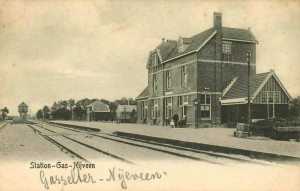
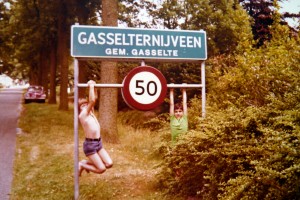
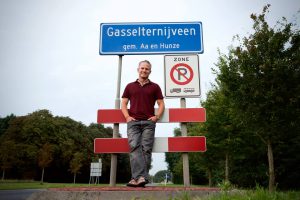 Is Nijveen a derivative of Gasselternijveen, a town my ancestors may have lived in? Gasselternijveen still exists today as a town of about 1,500. Many years ago, my third cousin, Micha Nijveen, was taken there by his father and snapped a photo. When he was there, he was told by his father that the town is indeed where our family came from. And if you map out where my distant ancestors were born, many of them do cluster in the region around Gasselternijveen. So maybe that really is the place. I went there in September 2016 and took my own photo next to the sign.
Is Nijveen a derivative of Gasselternijveen, a town my ancestors may have lived in? Gasselternijveen still exists today as a town of about 1,500. Many years ago, my third cousin, Micha Nijveen, was taken there by his father and snapped a photo. When he was there, he was told by his father that the town is indeed where our family came from. And if you map out where my distant ancestors were born, many of them do cluster in the region around Gasselternijveen. So maybe that really is the place. I went there in September 2016 and took my own photo next to the sign.
Or maybe the Nijveen name does not specifically come from the town of Gasselternijveen and is a more general geographical term describing one of the many bogs in the area. That might explain why many of my ancestors took on the name generations after they moved apart from each other.
Who knows. This is where things get a bit muddy, so to speak. I don’t know if it’s possible to continue the research on this point, and we may never know for sure.
Climbing the Tree
So when was the Nijveen name first used in my family? On my tree, this is the farthest back I can go patrilineally:
me
→
Donald “Don” Earl Nyveen
my father
Birth: June 27, 1940 in Montreal, Quebec, Canada
Death: December 5, 2011 (71) in Montreal, Quebec, Canada
→
Jacques “Jack” Nijveen/Nyveen
his father (my grandfather)
Birth: February 12, 1914 in Franeker, Franekeradeel, Friesland, Netherlands
Death: January 27, 1992 (77) in Montreal, Quebec, Canada
→
Benjamin “Ben”/Bernard/Bernhard Mozes/Nijveen/Nyveen
his father (my great grandfather)
Birth: October 1, 1887 in Stadskanaal, Groningen, Netherlands
Death: 1963 (76) in Montreal, Quebec, Canada
→
Yaaqov/Jakob/Jacob Mozes/Nijveen
his father (my second great grandfather)
Birth: October 4, 1853 in Martenshoek, Hoogezand-Sappemeer, Groningen, Netherlands
Death: January 19, 1921 (67) in Groningen, Netherlands
→
Mozes Samuels Mozes
his father (my third great grandfather)
Birth: September 7, 1821 in Foxhol, Hoogezand-Sappemeer, Groningen, Netherlands
Death: February 6, 1886 (64) in Hoogezand, Groningen, Netherlands
→
Samuël Mozes
his father (my fourth great grandfather)
Birth: June 19, 1782 in Drouwenerveen, Drenthe, Netherlands
Death: December 20, 1842 (60) in Veendam, Veendam, Groningen, Netherlands
→
Mozes/Mosis Jonas
his father (my fifth great grandfather)
Birth: estimated between 1718 and 1776
Death: October 1809
Before Napoleon, the Dutch used a patronymic system in which one’s last name would come from his father’s first name. Here, the pattern is obvious.
With Napoleon’s 1811 decree to identify families with permanent surnames, it seems that Samuël Mozes and his family registered the Mozes surname. Samuël’s son, Mozes Samuels Mozes, is awkwardly named because his first name comes from his father per the Dutch patronymic system while his last name was carried down per the decree.
Jacob Mozes was the first direct ancestor of mine to use the Nijveen name, but he wasn’t the first Nijveen in my family. A closer look at my tree shows that two generations earlier, around the time of the 1811 decree, some of Samuël’s siblings used Nijveen and yet another variation:
Frouke Simons Mozes van der Veen
Birth: 1777 in Gasselternijveen, Drenthe, Netherlands
Jonas Mozes Nijveen
Birth: January 1, 1787 in Gasselte, Aa en Hunze, Drenthe, Netherlands
Death: September 22, 1866 (79) in Gieten, Aa en Hunze, Drenthe, Netherlands
Jonas Mozes Mozes
Birth: 1789 in Gasselternijveen, Aa en Hunze, Drenthe, Netherlands
(records are conflicting, the two above might be the same person)
Salomon Mozes van der Veen
Birth: January 24, 1790 in Borger, Drenthe, Netherlands
Death: November 2, 1850 (60)
Samuël and many of his children were born in and around Gasselternijveen, suggesting that the first Nijveens DID take the name after the town they lived in. But there’s evidence that other, more distant cousins who did NOT live in Gasselternijveen also adopted the Nijveen name at around the same time. So maybe the name did NOT come from the place. Still others changed their names to Nijveen one or two generations later. Confusing.
Why did some members of my family change their names and not others? Why did some adopt the name Nijveen while others adopted other variations like “van der Veen”? Why did some of these name changes happen around the time of Napoleon’s decree and some much later?
We may never know the answers to these questions. In the Netherlands, official documentation before Napoleon’s decree is almost nonexistent, and Dutch common people around this time were mostly illiterate, so family records are sparse. Maybe they all DID change their names at the same time, and that it wasn’t until a few generations later, as each of them learned to read and write, that the Nijveen name started to appear in the written records.
The records that HAVE survived to the present day are incomplete and conflicting. We may never know for sure which family member was the first to be known as a Nijveen, to be documented as a Nijveen, or to be born as a Nijveen. All we know for sure is that the Nijveen name first appeared in my family around the time of Napoleon’s 1811 decree.
And it turns out we weren’t even the only Nijveens. I’ve found evidence of other families who were using the Nijveen name before 1727. These Nijveens and their descendants were from the same general region as my ancestors, but their religious background suggests that there was never any relation. There was even a Swedish Nyveen. The name isn’t nearly as unique as I once thought.
So now we have some background on what Nijveen means, where it may have come from, and when it came into use by my family. And we know that the name is not unique to my family. But when and why did Jacob Mozes, my second great grandfather, start using it?
The Family Business
The earliest Jews to be allowed to settle in the Netherlands came from the eastern side of its northern border from Germany. Most settled in the province of Groningen but were forbidden from permanently living in the city. As a result, the surrounding towns and villages began to support full-grown Jewish communities. But in the 16th and 17th centuries, prejudice and religious discrimination prevented Jews from living with and having the same opportunities as the rest of the Dutch. Jews would most commonly work professions related to trade: peddlers, salesmen, shopkeepers, merchants, cattle traders, textile manufacturers, and butchers.
According to a 1951 family biography, Jacob Mozes ran a family business which consisted of slaughtering horses, running a small packing plant, and managing a retail butcher shop. The biography doesn’t refer to Jacob by name or identify his business, but digitally archived government documents show that the name of the company was “Jacques Nijveen & Zoon” and that it was established in 1900.
Who was Jacques Nijveen? For whatever reason, Jacob Mozes seems to have used this alternate name professionally. Jacques is a French derivative of his Hebrew name Jacob, and Nijveen was a more generic, regional surname that was being used by other members of his extended family. Did my opportunistic great-great-grandfather figure that he could make more money if his name sounded less Jewish?
The name change for business reasons was my first thought, but there are problems with this theory. Butchers and meat traders were almost exclusively Jewish, and the business was located in the center of Groningen’s Jewish district. Everyone would have known that he was Jewish regardless of the name he used.
The interesting twist here is that Jacques butchered, processed, and sold horse meat, which is explicitly NOT kosher. How could he have been in the business of selling horse meat and likely be consuming it himself? Members of the Synagogue of Groningen have told me that Jews may not have had the luxury to choose which meat they ate in those days. Times were tough, and they had to eat what was available. The rabbi probably turned a blind eye to ensure that no one went hungry.
So while it seems that this is WHEN and WHERE Jacob started using these alternate names, WHY did it happen? Let’s see how the name was slowly adopted by the family over the years.
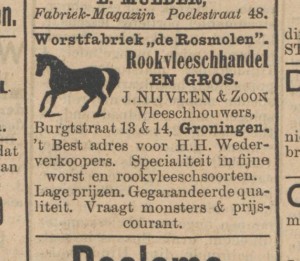
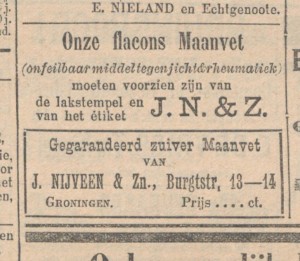 A June 15, 1901 Groningen newspaper advertisement for a Jacques Nijveen & Zoon sausage factory on Burgtstraat (now Burchtstraat) 13/14 is the earliest physical evidence of the Nijveen name that I’ve found. There’s also a September 13, 1901 ad for a gout and rheumatism remedy derived from horse fat.
A June 15, 1901 Groningen newspaper advertisement for a Jacques Nijveen & Zoon sausage factory on Burgtstraat (now Burchtstraat) 13/14 is the earliest physical evidence of the Nijveen name that I’ve found. There’s also a September 13, 1901 ad for a gout and rheumatism remedy derived from horse fat.
There are also records in the Leeuwarden archives of a slaughterhouse on Wijdesteeg 6 in the city of Leeuwarden in 1908. This company is identified as “Nijveen en Zoon, Firma Jacq.” Presumably, this was a new location for Jacques as he expanded his business to nearby cities, Leeuwarden being only about 65 km west of Groningen. I was recently contacted by a butcher in Leeuwarden who won at an auction a sign with “the words ‘horse meat’ and two horse heads”. He did a bit of research and determined that it belonged to a butchery at Voorstreek 312 once owned by Jacques and his son Charles. Charles later went out on his own and operated a butchery at Breedstraat 54, and this sign hung at these butcheries for over 50 years.
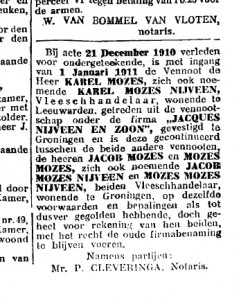 And it all seems to fit. In a January 3, 1911 Groningen newspaper, Jacques’ son Karel/Charles announced his resignation from the family business. All three family members, Jacques, Charles, and Jacques’ other son Mozes, are listed with the Nijveen name. Incidentally, my great-grandfather Bernard was another son of Jacques, but he was quite a bit younger than his brothers and may not have been as involved in the family business this early on.
And it all seems to fit. In a January 3, 1911 Groningen newspaper, Jacques’ son Karel/Charles announced his resignation from the family business. All three family members, Jacques, Charles, and Jacques’ other son Mozes, are listed with the Nijveen name. Incidentally, my great-grandfather Bernard was another son of Jacques, but he was quite a bit younger than his brothers and may not have been as involved in the family business this early on.
In 1912, Charles bought a farm at Damsingel 30 in Sumar, a small town just outside of Leeuwarden. He converted this farm into a butchery and smokehouse. This business would expand over the next few years and become a very successful enterprise. A company and processing plant exists there to this day.
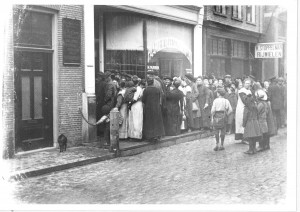 A new butcher shop was opened by the Nijveens in Groningen on 13 Folkingestraat, a street running down the center of the city’s Jewish district. A photo of this shop, circa 1918, shows the name of M. Nijveen on the window. This shop was likely run by Mozes.
A new butcher shop was opened by the Nijveens in Groningen on 13 Folkingestraat, a street running down the center of the city’s Jewish district. A photo of this shop, circa 1918, shows the name of M. Nijveen on the window. This shop was likely run by Mozes.
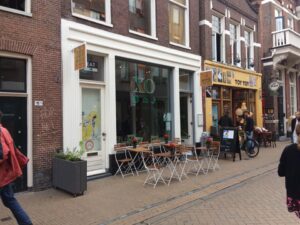 I visited this location in September 2016 and found that Folkingestraat has turned into the city’s trendiest neighborhood, full of boutiques, high-end retailers, and fancy cafes. The butcher shop was not a placed called Cafe XO, and I had my 40th birthday dinner there. As of February 2025, it looks like it has changed once again, now a restaurant called Puur! Natural Food.
I visited this location in September 2016 and found that Folkingestraat has turned into the city’s trendiest neighborhood, full of boutiques, high-end retailers, and fancy cafes. The butcher shop was not a placed called Cafe XO, and I had my 40th birthday dinner there. As of February 2025, it looks like it has changed once again, now a restaurant called Puur! Natural Food.
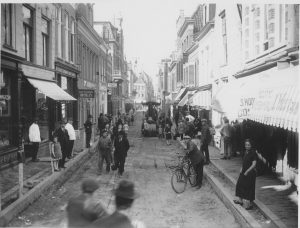 Another photo of Folkingestraat, circa 1925, clearly shows the Nijveen name on a sign over the butcher shop on a day they were resurfacing the street with a vintage steamroller.
Another photo of Folkingestraat, circa 1925, clearly shows the Nijveen name on a sign over the butcher shop on a day they were resurfacing the street with a vintage steamroller.
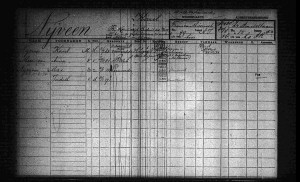 While the Nijveen name seems to have been used informally for many years, the earliest documentation of a legal name change from Mozes to Nijveen is a Royal Decree dated October 19, 1933 for Charles and his children who were still minors. Charles’ wife and an older daughter did not have their names legally changed, maybe because the name-changing process for married women was overly complicated. The timing of this change leads me to believe that it may have been motivated by increasing nationalistic antisemitism in nearby Germany and the rise of Hitler.
While the Nijveen name seems to have been used informally for many years, the earliest documentation of a legal name change from Mozes to Nijveen is a Royal Decree dated October 19, 1933 for Charles and his children who were still minors. Charles’ wife and an older daughter did not have their names legally changed, maybe because the name-changing process for married women was overly complicated. The timing of this change leads me to believe that it may have been motivated by increasing nationalistic antisemitism in nearby Germany and the rise of Hitler.
So while some members of my family took the Nijveen name around the time of Napoleon’s 1811 decree, my direct ancestors only started using the name in the early 1900’s. Perhaps the reason was to avoid antisemitism as the family business spread out from Groningen. We may never know for sure. But just before the beginning of World War II, the rest of my family seems to have jumped on board with the name change, most likely for exactly that reason.
From IJ to Y
The letter “y” didn’t exist in the old Dutch alphabet. But on Charles’ Royal Decree and in other handwritten depictions of the Nijveen name, the scripted “ij” looks curiously like a “ÿ”. Well, in Dutch, “ij” is a digraph (when two letters join to make a single sound) and a ligature (when two letters merge to become a single letter). And it turns out that when these letters appear in a Dutch proper name, they are often used interchangeably.
In Dutch names, interchangeability of ij and y is frequent. Some names have changed officially, for commercial reasons or by indifference:
- Johan Cruijff/Cruyff, former football player and manager
- Ruud van Nistelrooij/Nistelrooy, football player
- Piet Heijn/Heyn/Hein, a Dutch West India Company admiral
- Dirk Kuijt/Kuyt, football player
- Arie Luijendijk/Luyendyk, a race-driver
- Spijker/Spyker, car manufacturer
The Dutch football team of Feyenoord changed its name from the original “Feijenoord” to “Feyenoord” after achieving some international success.
…
In print, the letter ÿ (lowercase y with diaeresis) and ij look very different, but in the handwriting of most Dutch speakers, ÿ, ij and Y, IJ are identical.
So when did the Nijveen name first appear as Nyveen?
The Boat to Canada
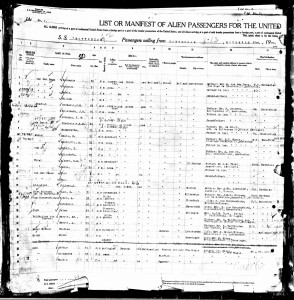
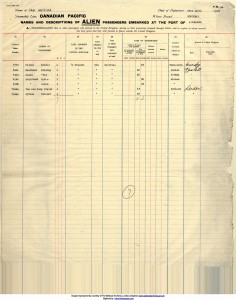
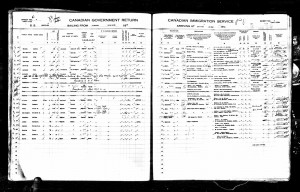
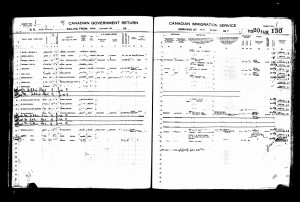 Bernard Nyveen found a job as a butcher on various steamship liners, allowing him to explore business opportunities in various port cities around the world. The family biography tells the story of Bernard Nyveen stepping ashore in New York in 1906, but I can’t find any documentation of this voyage.
Bernard Nyveen found a job as a butcher on various steamship liners, allowing him to explore business opportunities in various port cities around the world. The family biography tells the story of Bernard Nyveen stepping ashore in New York in 1906, but I can’t find any documentation of this voyage.
Charles and Mozes, Bernard’s older brothers, came to New York by boat in 1920, presumably to check things out for themselves. On the manifest, Charles anglicized his name from Nijveen to Nyveen. This is the first documented spelling of Nyveen that I have found in my family.
Bernard went back and forth to Holland a few times before returning in 1924 and permanently settling in Longueuil, Quebec. The earliest records of Bernard’s travels that I found are UK and Canada manifests from an April 24, 1925 – May 2, 1925 journey on the S.S. Montclare, showing his name spelled as Nyveen on both ends.
Was this change by choice, to make the name easier to spell and pronounce for Americans? Was it a clerical error? Or was the forced anglicization of foreign names standard procedure for immigrants to the US? We don’t know for sure.
On August 22, 1929, Bernard’s wife Josina and son Jacques came to Canada on the S.S. Montclare. That manifest shows them both as Nyveens.
Wrapping It Up
So who was the first Nijveen? Don’t know. The name seems to have been adopted at different times by many families, some of them unrelated. My first direct ancestor who was a Nijveen seems to have been a horse butcher named Jacob, known professionally as Jacques.
The first Nyveen was one of Jacob’s sons, either Bernard or Charles. The earliest manifests I’ve found show Charles as a Nyveen, but Bernard may have actually used the name first. The first to be born a Nyveen was Don, my father.
The Name Today
Along with the spelling change, the pronunciation has been anglicized as well. Nowadays, at least in Canada and the US, Nyveen rhymes with “Visine“.
All the Nyveens who ever lived in Canada and the US are close relatives.
Having such a unique last name certainly makes the online research easier, but having to spell out my name every time I make a reservation or appointment over the phone or every time I close a tab at a bar or club gets a bit annoying.
More than once, it’s been misspelled Nguyen, and I’ve walked into meetings and interviews surprising people that I’m a white guy. Growing up, mail used to come addressed to Mr. Nyreen, Mr. Nyven, or Mr. Nyzeen, though this isn’t happening much anymore now that mailing lists are coming from digital records.
Connections
- The present-day distribution of Nijveens in the Netherlands seems to show them scattered around, though there is still some concentration of them in and around Groningen. Perhaps some of them are my distant relatives.
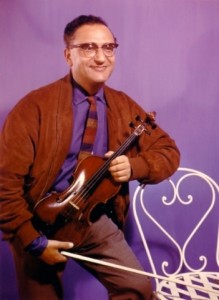 Sem Nijveen was a famous violinist in the Netherlands in the 50’s, 60’s, and 70’s. He’s my second cousin, twice removed. (He was amazing. Click here to see him perform. He’s the violinist who appears first in the video. He’s performing with his cousin, Benny Behr.) Born a Mozes, he was known as a Nijveen professionally and legally changed his name to Nijveen in 1972.
Sem Nijveen was a famous violinist in the Netherlands in the 50’s, 60’s, and 70’s. He’s my second cousin, twice removed. (He was amazing. Click here to see him perform. He’s the violinist who appears first in the video. He’s performing with his cousin, Benny Behr.) Born a Mozes, he was known as a Nijveen professionally and legally changed his name to Nijveen in 1972.- Leo Nijveen was a truck driver who, perhaps unknowingly, trafficked 50 Chinese immigrants from Belgium to the UK in April 2000. Nijveen was released for lack of evidence, but his freight company was fined $150,000. Don’t think there is a relation.
- nijveen.com is registered to a Rolf Nijveen. He seems to enjoy traveling but does not enjoy answering questions about his family.
- nyveen.com is registered to my cousin’s husband. Maybe I’ll put this on that domain someday.
- Jeffrey Veen, a techie who works at Adobe, probably has the one name in the world most similar to mine.
- John Nuveen, founder of Nuveen Investments, may have been a distant relative. No response to an email I sent to the company a while back.
- I found a Canadian girl of Middle Eastern descent named Nyveen Mehri whose FIRST name is Nyveen. Very weird. I contacted her a while back, and she said that her mother was going to name her Naveen but wanted to come up with a more unique spelling. Naveen is a common Indian/Sanskrit first name that means “new”.
- In November 2023, I was contacted on LinkedIn by a Jeffrey Nijveen who lives in the Netherlands. So cool!
Thanks
Special thanks to:
- government of the Netherlands and Dutch genealogical organizations for archiving and allowing public access to their historical documents
- Ancestry for scanned images of ship manifests and boats (a one month membership got me most of the scans you see above)
- Google for the imperfect but incredibly useful Google Translate
- Wikipedia for historical background on the Netherlands
- Menno Tienstra and Els Thuis for searching the Dutch archives and the helpful translations
- Micha Nijveen for his family stories and background
- Chris van Wierst of the Synagogue of Groningen for his historical information
- Hedzer Nicolay for acquiring the horse sign in Leeuwarden and sharing some historical details
- Annelies Erwteman and Susan Cohn for their insightful family background and photos
- Wytse Sikkema, historian for the Hondsrug UNESCO Global Geopark website
- the other Nijveens around the world I’ve contacted and annoyed with my questions
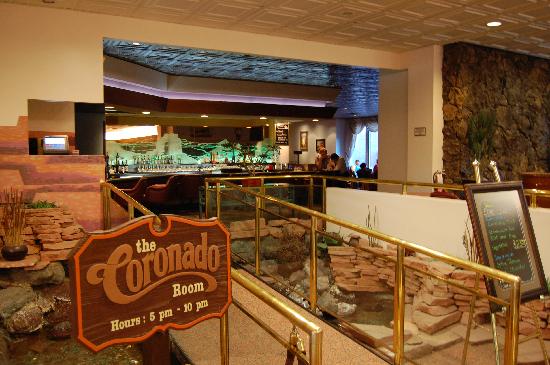
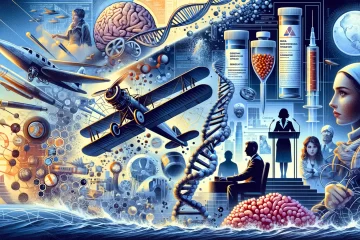
6 Comments
Pauline · April 29, 2013 at 10:12 am
That was really interesting. It’s awesome that you’re the second generation of your last name. I am too, since Pait was the name given to my dad even though it was neither my grandmother or grandfather’s last name. Any other Pait you would meet in Texas will definitely have my DNA! I like having a unique name, even though there are always red lines under it every time i type it..
It’s amazing how you were able to find so much detail about your heritage. I used to think learning anything about my dad’s side of the family was a lost cause. But not anymore 🙂
Paula Blitstein · February 19, 2017 at 5:28 am
VERY interesting Jeff!
Jonathan posted your Claire Danes blog on FB.
Coincidentally I’m visiting them & just brought Jenn the Feb 2017 issue of Bazaar with Claire Danes on the cover!
Hope all’s well.
Jeff · March 9, 2017 at 1:35 am
Tell her I say hello!
Bill Holland · September 24, 2019 at 10:19 am
Hi Jeff,
I’m trying to get in touch with direct descendants of Sem Nijveen, particularly his son Micha.
Do you have an email address? I’m a fan of Sem’s work and I have a request to make.
Hope you can help.
Bruce Small · December 21, 2019 at 10:28 am
Jeff,
I went to school with Don and remember well going over to his house to read his collection of comic books. He always shared his matzo with me and that was much appreciated. I thought the world of his dad, Jack. Don had a blog with photos of his tour of Israel. By any chance do you have a link to that blog.
Your analysis of your family history is amazing, by far the best I’ve ever read, both the depth and your excellent writing.
Jeff · December 14, 2020 at 11:43 pm
Hey Bill, sorry, just now seeing this! Will reply privately.